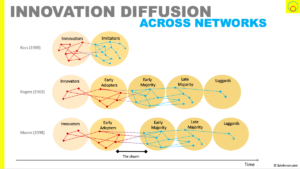Innovations diffuse - knowledge spreads - across a social system through communication channels over time.
We'll take a network-centric view of diffusion and see how Bass' model and Rogers' adoption curve help us understand diffusion
Then we'll look at Moore's crossing the chasm and Maloney's 16% rule to understand some issues. And finally look at the tipping point, and Gladwell's mavens, connectors and salesmen.







